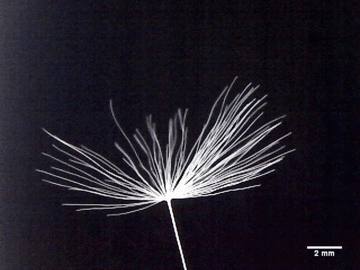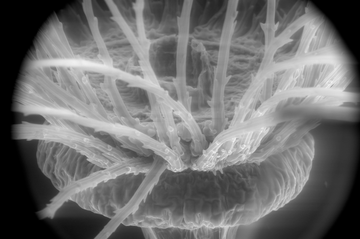
Small amounts of moisture cause the dandelion seed parachute to close like an inverted umbrella
Madeleine Seale 2022
They found that a radial structure at the centre of the parachute swells when wet, which allows it to open and close like an inverted umbrella.
Understanding the mechanics of how plants ‘migrate’ and find favourable environments for growth is crucial to understanding plant adaptations to climate change. The findings could also lead to new designs in robotics.
Previous research has shown that the opening of the dandelion parachute is affected by how much water is in the air, known as atmospheric humidity. In dry conditions, this means seeds fall to the ground slower compared to more humid conditions. However, how the opening of the parachute occurs was still a mystery.
An international team of researchers from Oxford, Edinburgh, London, Lyon, and Palaiseau used a combination of concepts and approaches from plant biology and mechanical engineering to help shed more light on the problem.
The team studied the structure of dandelion seeds under the microscope to understand what was going on.
“One experiment involved painting tiny parts of the dandelion seeds with nail polish to try to block their movement. This involved tying up their hair with string so it was a bit like taking them to the beauty salon.”
Madeleine Seale
The team then made a computational model to test which features of the structure were required for the change of shape, known as morphing. They found that the individual hairs of the dandelion parachute were attached to a circular plate, called the actuator. As this actuator swells, the hairs move and close the parachute. Most intriguingly, the individual tissue types do not need to swell in a specific direction, but instead need to be attached to each other within the actuator to cause overall directional movement.
To their surprise they also found that empty space in the centre of the actuator is essential. It’s not just about swelling of the material itself, but also how the cells are geometrically arranged.
“Remarkably, this all happens with dead cells – just from the ability of the tissue to absorb and release water”
Madeleine Seale
Engineering can often take inspiration from biology. In many cases biology has had millions of years of evolution to perfect and optimize structures for specific purposes. This work may aid engineering design to make small actuators that efficiently change shape or sensors that can respond to humidity. As no active biological signalling or energy is required, this morphing structure should be quite straightforward to recreate with artificial materials.

The apical plate of the dandelion seed head acts as an actuator that opens and closes the hairs
Madeleine Seale & Jim Buckman 2022
To read more about this research published in Nature Communications, please visit: https://www.nature.com/articles/s41467-022-30245-3.